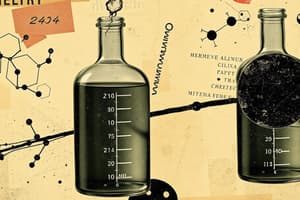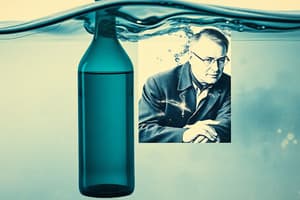Podcast
Questions and Answers
Which of the following statements correctly describes the bond within a water molecule?
Which of the following statements correctly describes the bond within a water molecule?
- The bond is metallic, with the electrons being delocalized between the oxygen and hydrogen atoms.
- The bond is covalent, with oxygen sharing two electrons with each hydrogen atom. (correct)
- The bond is ionic due to the transfer of electrons from hydrogen to oxygen.
- The bond is hydrogen, forming a weak attraction between the hydrogen and oxygen atoms.
What is the primary reason why water molecules exhibit a bent (V-shaped) structure?
What is the primary reason why water molecules exhibit a bent (V-shaped) structure?
- The equal sharing of electrons between the hydrogen and oxygen atoms.
- The presence of two lone pairs of electrons on the oxygen atom. (correct)
- The strong attraction between the hydrogen and oxygen atoms.
- The tendency of water molecules to form hydrogen bonds.
The partial positive and negative charges on a water molecule result from:
The partial positive and negative charges on a water molecule result from:
- The transfer of electrons from hydrogen to oxygen.
- The formation of hydrogen bonds between water molecules.
- The equal sharing of electrons between the oxygen and hydrogen atoms.
- The uneven sharing of electrons between the oxygen and hydrogen atoms. (correct)
Which of the following best describes the nature of hydrogen bonds in water?
Which of the following best describes the nature of hydrogen bonds in water?
How do the properties of water molecules, such as their polarity and ability to form hydrogen bonds, contribute to its role as a universal solvent?
How do the properties of water molecules, such as their polarity and ability to form hydrogen bonds, contribute to its role as a universal solvent?
Which of the following is NOT a reason why water is considered a universal solvent?
Which of the following is NOT a reason why water is considered a universal solvent?
Which of the following best describes the property of water that allows a spider to walk on water?
Which of the following best describes the property of water that allows a spider to walk on water?
What causes the high surface tension of water?
What causes the high surface tension of water?
Which of the following statements about the salinity of seawater is TRUE?
Which of the following statements about the salinity of seawater is TRUE?
Which of the following is NOT a factor that contributes to the salinity of seawater?
Which of the following is NOT a factor that contributes to the salinity of seawater?
How does the speed of sound in seawater change with increasing depth?
How does the speed of sound in seawater change with increasing depth?
Which of the following properties of water is MOST responsible for its ability to moderate temperature fluctuations on Earth?
Which of the following properties of water is MOST responsible for its ability to moderate temperature fluctuations on Earth?
Which statement accurately describes how the physical properties of seawater vary with water depth?
Which statement accurately describes how the physical properties of seawater vary with water depth?
What is the general behavior of most materials when heated?
What is the general behavior of most materials when heated?
How much greater is the pressure at a depth of 4,000m compared to the surface pressure?
How much greater is the pressure at a depth of 4,000m compared to the surface pressure?
Which color of light penetrates the deepest in seawater?
Which color of light penetrates the deepest in seawater?
What is the average velocity of sound in the ocean?
What is the average velocity of sound in the ocean?
What happens to the speed of sound in water as temperature increases?
What happens to the speed of sound in water as temperature increases?
What property of water allows it to moderate temperatures more effectively than land?
What property of water allows it to moderate temperatures more effectively than land?
Which process is defined as the diffusion of water across a semi-permeable membrane?
Which process is defined as the diffusion of water across a semi-permeable membrane?
What is the latent heat of vaporization?
What is the latent heat of vaporization?
Why do continental regions experience a larger annual temperature range compared to oceans?
Why do continental regions experience a larger annual temperature range compared to oceans?
What happens during the latent heat of condensation?
What happens during the latent heat of condensation?
What is the primary factor causing northern hemisphere regions to have warmer summers than the southern hemisphere?
What is the primary factor causing northern hemisphere regions to have warmer summers than the southern hemisphere?
During which phase change is latent heat of freezing released?
During which phase change is latent heat of freezing released?
What is the main reason that diffusion occurs in liquids?
What is the main reason that diffusion occurs in liquids?
Flashcards
Water Molecule
Water Molecule
A molecule composed of two hydrogen atoms covalently bonded to one oxygen atom.
Covalent Bonds
Covalent Bonds
Strong bonds formed when atoms share electrons, like in water.
Partial Charges
Partial Charges
Uneven distribution of electron density leading to slight positive and negative charges in a molecule.
Outer Electron Shells
Outer Electron Shells
Signup and view all the flashcards
Hydrogen Bonding
Hydrogen Bonding
Signup and view all the flashcards
Hydrogen Bonds
Hydrogen Bonds
Signup and view all the flashcards
Cohesion
Cohesion
Signup and view all the flashcards
Adhesion
Adhesion
Signup and view all the flashcards
Surface Tension
Surface Tension
Signup and view all the flashcards
Universal Solvent
Universal Solvent
Signup and view all the flashcards
Salinity
Salinity
Signup and view all the flashcards
Thermal Properties
Thermal Properties
Signup and view all the flashcards
Effects of Depth
Effects of Depth
Signup and view all the flashcards
Thermal Expansion
Thermal Expansion
Signup and view all the flashcards
Pressure in the Ocean
Pressure in the Ocean
Signup and view all the flashcards
Light Attenuation
Light Attenuation
Signup and view all the flashcards
Blue Light Penetration
Blue Light Penetration
Signup and view all the flashcards
Sound Speed in Water
Sound Speed in Water
Signup and view all the flashcards
Osmosis
Osmosis
Signup and view all the flashcards
Specific Heat Capacity
Specific Heat Capacity
Signup and view all the flashcards
Latent Heat
Latent Heat
Signup and view all the flashcards
Latent Heat of Vaporization
Latent Heat of Vaporization
Signup and view all the flashcards
Latent Heat of Condensation
Latent Heat of Condensation
Signup and view all the flashcards
Latent Heat of Freezing
Latent Heat of Freezing
Signup and view all the flashcards
Temperature Range of Continents vs Oceans
Temperature Range of Continents vs Oceans
Signup and view all the flashcards
Diffusion
Diffusion
Signup and view all the flashcards
Study Notes
Water and Seawater
- The learning outcomes for this topic are to: describe the basic chemistry of water; discuss water properties like surface tension, solvency, salinity, thermal, sound and light transmission, and pressure; and describe how seawater's properties change with depth.
Chemistry of Water
- Water molecules are formed by covalent bonds between hydrogen and oxygen atoms.
- The structure of a water molecule is based on the arrangement of outer electron shells and partial charges, which results in hydrogen bonding.
Properties of Water
- Surface tension: Water has a high surface tension due to cohesion, allowing it to resist external forces.
- Solvent: Water is a universal solvent, dissolving many polar and ionic substances due to its polarity.
- Salinity: Dissolved salts contribute to seawater's salinity.
- Thermal properties: Water has a high specific heat capacity, meaning it can absorb significant heat without a large temperature change.
- Sound transmission: Sound travels faster in water than in air, and the speed increases with temperature and pressure.
- Light transmission: Light is attenuated in seawater, with violet light penetrating the deepest. Red light attenuates at shallow depths.
Composition of Seawater
- Seawater's composition includes various dissolved ions (e.g., chloride, sodium, sulfate, magnesium and calcium), their concentrations vary slightly from place to place.
- Volcanic eruptions, weathering of rocks, and leaching from mid-ocean ridges contribute to seawater's composition.
Salinity and Osmoregulation
- Diffusion moves molecules from high concentration areas to low concentration.
- Diffusion of solvent is known as osmosis.
- Water can cross cell membranes freely but most salts cannot.
- Cells regulate salt balance for survival.
Thermal Properties of Water
- Specific heat capacity (SHC) is the amount of heat required to raise the temperature of 1 gram of substance by 1°C
- Water has a high SHC compared to other substances, affecting temperature fluctuations in the environment.
Latent Heat
- Latent heat is the heat absorbed or released during a phase change (e.g., melting, freezing, vaporization) without a temperature change.
- This occurs at a constant temperature.
Phase Changes of Water
- Water undergoes phase changes (solid-liquid-gas).
- Heat is either absorbed or released during each change of phase.
Thought Exercise
- Continental areas exhibit wider yearly temperature ranges compared to coastal locations due to water's high specific heat capacity.
Density and Thermal Expansion of Water
- Most materials expand when heated and contract when cooled.
- Pure water is an exception, reaching maximum density at 4°C.
- Seawater's density is affected by salinity and temperature.
Pressure in the Ocean
- Ocean pressure increases with depth.
- Pressure is approximately 400 times greater at 4000m than at the surface.
Pressure and Gases in Organisms
- Organisms in deep water encounter increased pressure and adapt to it.
- Breathing mechanisms and blood composition of marine animals are suited to conserve oxygen and manage pressure changes
Light in the Ocean
- Light is considerably reduced at deeper depths within the ocean.
- Different wavelengths of visible light penetrate to varying degrees in seawater.
Sound in the Ocean
- Sound travels significantly faster in water than in air.
- The speed of sound in water is also impacted by temperature and pressure.
- Sound waves may travel in distinctive channels
Studying That Suits You
Use AI to generate personalized quizzes and flashcards to suit your learning preferences.




